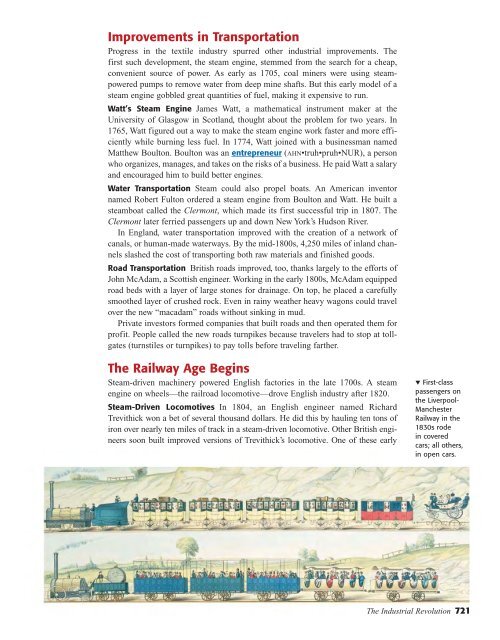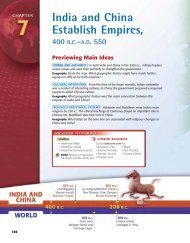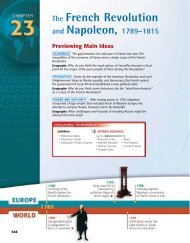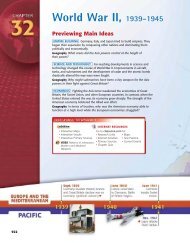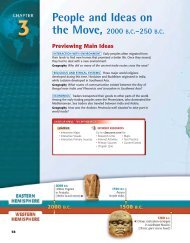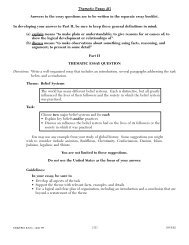The Industrial Revolution, 1700– 1900 Previewing Main Ideas
The Industrial Revolution, 1700– 1900 Previewing Main Ideas
The Industrial Revolution, 1700– 1900 Previewing Main Ideas
Create successful ePaper yourself
Turn your PDF publications into a flip-book with our unique Google optimized e-Paper software.
Improvements in Transportation<br />
Progress in the textile industry spurred other industrial improvements. <strong>The</strong><br />
first such development, the steam engine, stemmed from the search for a cheap,<br />
convenient source of power. As early as 1705, coal miners were using steampowered<br />
pumps to remove water from deep mine shafts. But this early model of a<br />
steam engine gobbled great quantities of fuel, making it expensive to run.<br />
Watt’s Steam Engine James Watt, a mathematical instrument maker at the<br />
University of Glasgow in Scotland, thought about the problem for two years. In<br />
1765, Watt figured out a way to make the steam engine work faster and more efficiently<br />
while burning less fuel. In 1774, Watt joined with a businessman named<br />
Matthew Boulton. Boulton was an entrepreneur (AHN•truh•pruh•NUR), a person<br />
who organizes, manages, and takes on the risks of a business. He paid Watt a salary<br />
and encouraged him to build better engines.<br />
Water Transportation Steam could also propel boats. An American inventor<br />
named Robert Fulton ordered a steam engine from Boulton and Watt. He built a<br />
steamboat called the Clermont, which made its first successful trip in 1807. <strong>The</strong><br />
Clermont later ferried passengers up and down New York’s Hudson River.<br />
In England, water transportation improved with the creation of a network of<br />
canals, or human-made waterways. By the mid-1800s, 4,250 miles of inland channels<br />
slashed the cost of transporting both raw materials and finished goods.<br />
Road Transportation British roads improved, too, thanks largely to the efforts of<br />
John McAdam, a Scottish engineer. Working in the early 1800s, McAdam equipped<br />
road beds with a layer of large stones for drainage. On top, he placed a carefully<br />
smoothed layer of crushed rock. Even in rainy weather heavy wagons could travel<br />
over the new “macadam” roads without sinking in mud.<br />
Private investors formed companies that built roads and then operated them for<br />
profit. People called the new roads turnpikes because travelers had to stop at tollgates<br />
(turnstiles or turnpikes) to pay tolls before traveling farther.<br />
<strong>The</strong> Railway Age Begins<br />
Steam-driven machinery powered English factories in the late 1700s. A steam<br />
engine on wheels—the railroad locomotive—drove English industry after 1820.<br />
Steam-Driven Locomotives In 1804, an English engineer named Richard<br />
Trevithick won a bet of several thousand dollars. He did this by hauling ten tons of<br />
iron over nearly ten miles of track in a steam-driven locomotive. Other British engineers<br />
soon built improved versions of Trevithick’s locomotive. One of these early<br />
▼ First-class<br />
passengers on<br />
the Liverpool-<br />
Manchester<br />
Railway in the<br />
1830s rode<br />
in covered<br />
cars; all others,<br />
in open cars.<br />
<strong>The</strong> <strong>Industrial</strong> <strong>Revolution</strong> 721


